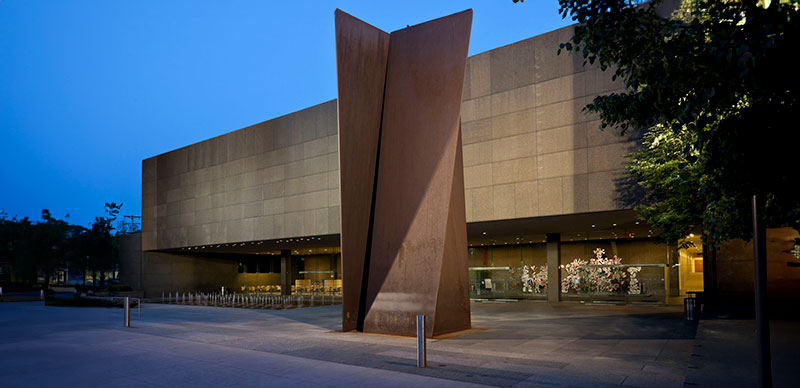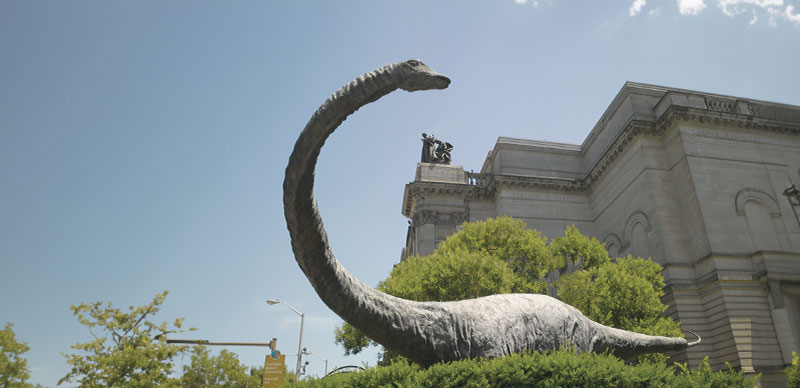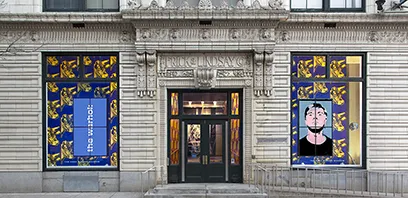Home
Museums
Back Issues
Membership
Green Eaglesmere set 3, 1997
May 6 August 6, 2000
By Ellen S. Wilson
Pittsburghers have long
experienced the beauty of Brice Mardens paintings. His paintings were
amply represented in the 1985 Carnegie International, and again
in the 1988 International, from which his painting Untitled 2
was acquired for the collection. Because his painting had changed so much
in the intervening years, it was entirely possible for visitors to the
later International not to recognize work by the artist they had
admired three years earlier.
Marden established himself in the 1960s as a downtown
New York personality, a friend of musicians, dancers, and performers. He
produced large monochrome paintings using a mixture of beeswax and pigment
applied to a primed canvas, creating smooth, rich surfaces from a limited
palette of pale grays, greens, and tans. Always influenced by place, he
broadened his color palette after he began spending summers on the Greek
island of Hydra in 1973. His panel paintings from this period invoke the
classic lines of Greek architecture.
While still composed of simple shapes and pure colors,
the Greek paintings have a dynamic quality. “You paint a panel and it usually
means something has to happen to the panel next to it, you have to make
changes to that panel,” Marden explained in a 1978 interview. “See, youre
always going back and forth. Youre trying to figure it out, to make a
colour brighter, bring the value up, take it down.” Charles Wylie, organizer
of Brice Marden, Work of the 1990s: Paintings, Drawings and Prints for
the Dallas Museum of Art, says The Seasons, a four-panel work from
1975, “reverberates with an inner light that re-creates [Mardens] own
memory and impression of what the seasons have been for him, and what the
colors might look like that correspond to that memory.”
Several works from this early stage in Mardens artistic
life were shown in the 1985 Carnegie International. By 1988, Mardens
work had taken off in an entirely new direction, and the beginnings of
the style he would pursue in the 1990s could be seen.
“A proposed commission to design stained-glass windows
for the Basel Cathedral was a catalytic experience for Marden,” says Richard
Armstrong, The Henry J. Heinz II Director, Carnegie Museum of Art. “His
drawings–while still grid-based–became noticeably looser and more gestural.”
Mardens work was further changed by a professional crisis
at the same moment in 1984, which almost caused him to abandon painting
altogether. “It was a typical dry spell,” Armstrong comments. “Artists
go through working cycles: Marden had been remarkably productive since
the 1960s, and this period of questioning was a milestone in his development.”
An exhibition of calligraphy awakened Mardens interest in this Chinese
art and in Chinese culture, which led in turn to the introduction of the
calligraphic line in subsequent work. As Sarah McFadden wrote in the 1988
Carnegie
International catalogue, Marden began “to paint the drawings, or, more
accurately, to draw with paint.”
“I like the idea that this [calligraphic] form doesnt
exist in the West,” Marden told David DArcy of The Art Newspaper
in April 1999. “You dont have something that can be read that can also
be purely aesthetic. Its artwork that communicates in a different way
than Western artwork.”
The paintings from this period show evidence of numerous
corrections, rubbing out, sanding down, somelines reduced to shadows that
can barely be seen through the pigment. McFadden notes the “gestural abandon”
of these works, which reflects the influence of Franz Kline and Jackson
Pollock.
I just went into these paintings and started a line. It seemed much
more intuitive at that point.
Marden began the 1990s with the completion of Cold
Mountain, a suite of paintings, drawings, and prints inspired by the
writings of Han Shan, an eighth-century Chinese poet whose name literally
translates as “cold mountain.” While Marden followed the strict rules of
calligraphybeginning in the upper right corner of the canvas and working
left and down”the characters in Mardens paintings are of his own invention,”
explains Dallas curator Charles Wylie in the exhibition catalogue;
they “become webs that intertwine, creating complicated relationships between
one area of the canvas and the next.” The influence of Pollock is also
evident in these recent works, both in their increased scale and the way
in which the sinuous lines literally dance off the canvas.
The next important suite of paintings Marden created in
the 1990s are the so-called “Muse” paintings, which marry, as Wylie points
out, calligraphic structure with a classical Greek subject. Just as he
was strongly influenced by place in his earlier Greek paintings, Marden
continues to draw on the sensations he experiences in Hydra, as well as
at Eaglesmere, his home in northeastern Pennsylvania, producing “Muse”
paintings at both locations.
While these new works resist literal interpretations,
their titles February in Hydra, Prayer Flags, Aphrodite do suggest
the presence of dancing muses or a Venus figure. Like all of Mardens works,
they are about the processthe physicality of applying the paint to the
canvasbut they are also about something else. “You deal with illusion,”
Marden explained in 1980. “But its not illusion about things that you
see. Its an illusion of an abstraction of things that you see. Im not
painting trees and flowers, even if I use a landscape image.”
By the late 1990s Marden had let go of the calligraphic
model. “I didnt start off with the characters in the upper right and then
work down and over as I had before with the calligraphy paintings. There
arent any columns anymore or things connecting columns. I just went into
these [paintings] and started a line. It seemed much more intuitive at
that point,” he told Wylie in a 1998 conversation. One key painting from
this period is The Sisters, which represents the relationship between
Mardens two daughters. This work can, according to Wylie, “be seen as
two figures next to one another; however, the painting seems to be more
about the way in which one human can be part of and separate from another
human and remain locked within each others orbit of existence.”
Although the viewer can see in The Sisters an emotional
territory to explore, the gradual loosening of Mardens self-imposed restrictions
over the last four decades also results in a visual delight. Mardens paintings
and drawings are captivating on many levels; and, after all the interpretation
and scholarly inspection, fundamentally the works are rather straightforward.
They are, at least, to the artist. “I paint nature,” he said in 1980. “I
mean, I refer to nature. I accept nature as a reality; its the best reference;
its what the paintings about.”
“This has been a remarkably rich decade for Marden,” Armstrong
says. “Recalling that our mission is to acquaintand reacquaintmuseum
audiences with the work of todays finest living artists, the Marden show
became especially attractive for us to present. Recent exhibitions here
that might be considered comparable would be the 1998 Georg Baselitz exhibition,
and last summers Christopher Wool exhibition. Marden is older than Wool,
and more established. It is a unique pleasure to watch a mature artist
reinvent his work.”
Brice Marden on Beauty
Q: Most people think your work is beautiful. Is the beauty
of the object a consideration for you?
Brice Marden: Beauty. I really relate to form. If the
form is resolved, its beautiful. The idea of beauty can be offensive.
Q: What do you mean?
M: Maybe beauty is too easy. It doesnt deal with issues;
political issues or social issues. But an issue that it does deal with
is harmony . . . One of the reasons I wanted to do this work was that by
using the monochromatic palette in the past basically all I could get were
chords. I wanted to be able to make something more like fugues, more complicated,
back-and-forth renderings of feelings.
From an interview with artist Pat Steir, 1991
Home
Museums
Back Issues
Membership
Copyright (c) 2000 CARNEGIE magazine
All rights reserved.
E-mail: carnegiemag@carnegiemuseums.org



